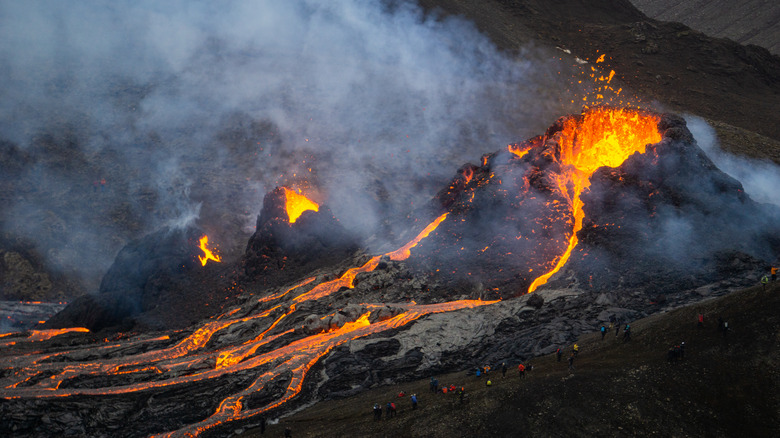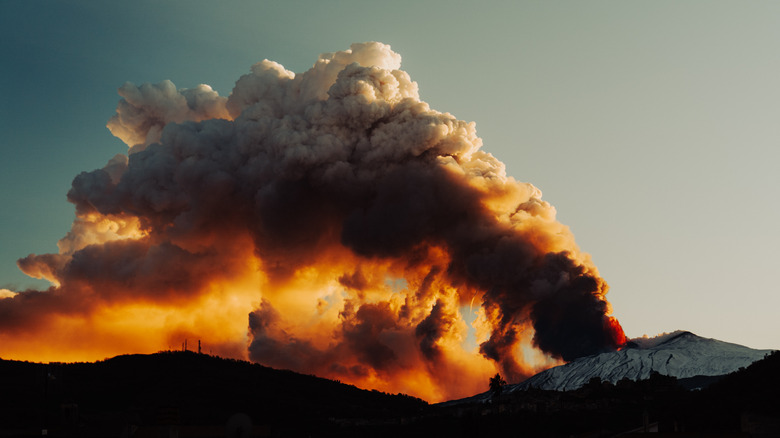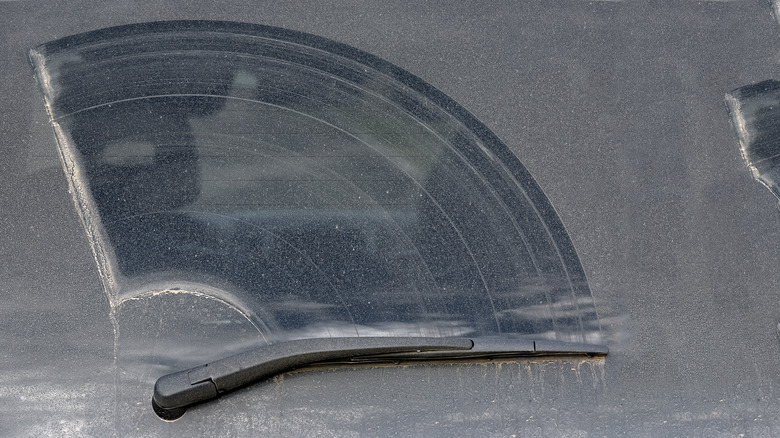What Are The Dangers That Trigger An Ashfall Advisory After A Volcanic Eruption?
Hawai'i's Mauna Loa, the world's largest active volcano, erupted for the first time in almost 40 years on November 28, 2022 (via CNN). As of now, the eruption is not expected to produce lava flows that would imperil Hawai'ians living downhill, nor are the toxic gasses that can sometimes be belched out by volcanoes expected to be a danger at this time. "If the eruption remains in [the summit area], lava flows will most likely be confined within the caldera walls," said the Hawai'ian Volcano Observatory.
There is, however, one aspect of volcanic eruptions that people living in the area are not going to be able to avoid: ash. And in fact, officials have invoked an ashfall advisory. As much as under a quarter inch of it could fall, and like snow, it can accumulate and cause all manner of problems for the people and animals that are going to have to deal with it. And unlike snow, volcanic ash doesn't melt, meaning it's going to be around for a while. As the National Weather Service notes, volcanic ash can disrupt air travel, damage buildings and vehicles, and harms humans and animals' eyes and lungs, among other things.
Volcanic Ash Can Be Deadly To Humans And Animals
According to the National Weather Service, volcanic ash is abrasive, which means that it can irritate the eyes and lungs of humans, as well as pets and livestock. And the threat to human health from volcanic ash is just as real as the threat of death from burning or suffocating to death from hot gases; as UPI reported in 1981, autopsies of the victims of the Mt. St. Helens eruption — those whose bodies had been recovered, that is — revealed that most of the 35 fatalities were the result of people who died more or less instantly from breathing in the volcanic ash or suffocating from it. The people of Pompeii, for whatever it's worth, got off relatively light: So hot and toxic were the gasses that emerged from Mt. Vesuvius that, according to National Geographic, they were baked alive, more or less instantly, before having time to suffocate from breathing in the ashes.
Even those who don't die from it are likely to wish they hadn't breathed it in, however. As the United States Geological Survey notes, mild symptoms of volcanic ash inhalation include irritation of the eyes, nose, and throat, and it can create a hacking cough that lasts days. People with existing respiratory conditions, such as asthma and/or bronchitis, can expect to have it even worse.
Mitigating The Danger
The National Weather Service in Honolulu gave Hawai'ians the simplest and most straightforward bit of advice for avoiding danger from volcanic ash: stay inside. And if you absolutely have to go outside, wear a mask. "People with respiratory illnesses should remain indoors to avoid inhaling the ash particles and anyone outside should cover their mouth and nose with a mask or cloth," the agency said via CNN. More specifically, the Centers for Disease Control and Prevention (CDC) recommends the use of an N-95 particulate respirator, the type that should be available at a local hardware store.
Keeping ash particles outside and not letting them inside is also a top priority. To that end, officials recommend turning off climate control systems, such as air conditioning, lest particles are sucked inside, as well as keeping windows closed and covering potential drafts with a wet towel. Residents are also asked not to travel if at all possible to avoid stirring up the particles as well as to avoid having them sucked into vehicles' machinery, where they can wreak even more havoc.
Getting Rid Of Volanic Ash Is An Epic Nightmare
Volcanic ash is like snow in that its fall is measured in inches or fractions of an inch — in this case, less than a quarter of an inch is expected, per CNN — and can pile up wherever it lands. Unlike snow, however, volcanic ash isn't going to melt when it gets warmer, and getting rid of it takes herculean effort.
On a micro scale — such as cleaning up around your home — the United States Geological Survey recommends dressing head to toe and using face and eye protection, and using vacuums instead of dust blowers. Since avoiding kicking up particles is the order of the day, the agency recommends using damp mops and cloths. On a macro scale — removing ash from city streets, for example — getting rid of ash is going to take a coordinated effort. National Geographic points to the city of Yakima, Washington, in the aftermath of the Mt. St. Helens eruption as an example, noting that the city collected 544,000 metric tons of the stuff and deposited it in landfills. The operation took seven 24-hour days and cost the city $5.4 million in 1980 dollars.



